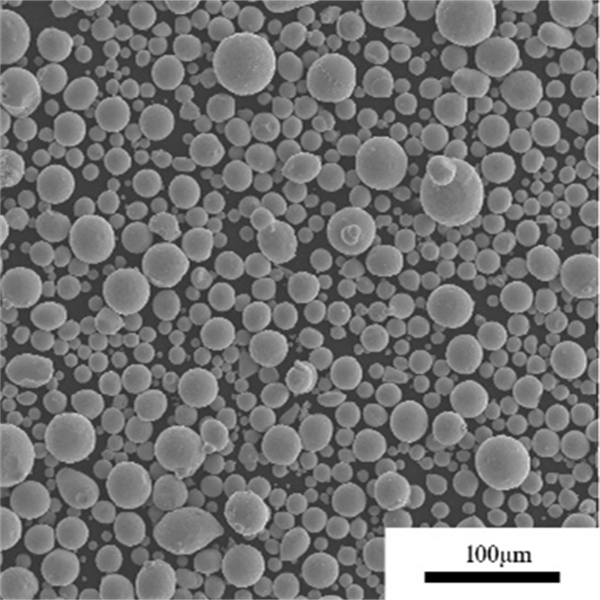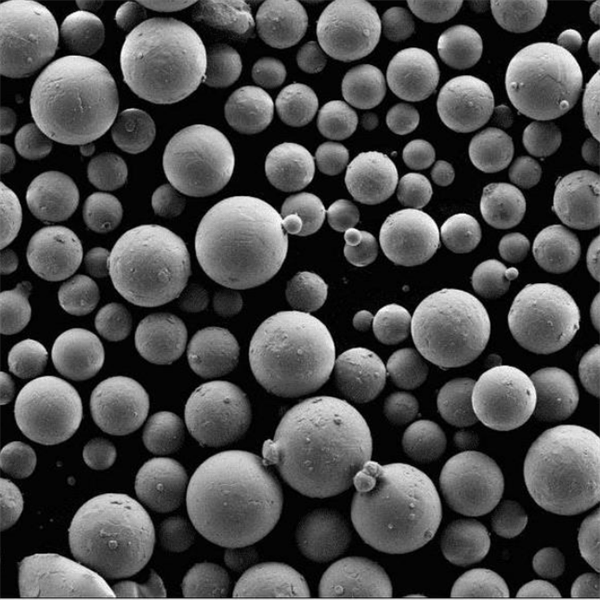メタルアトマイゼーション:概要,サプライヤー,利点
目次
金属の微粒化 金属を噴霧化によって塊状から微細な粉末金属に変換するプロセスです。これは、さまざまな業界のさまざまな用途の金属粉末の製造によく使用されます。この記事では、金属噴霧化に関する重要な側面を詳細に説明した包括的なガイドを提供します。
金属アトマイゼーションの概要
金属の噴霧化では、高速のガスまたは液体の流れを使用して溶融金属を微細な液滴に分解します。液滴が飛行中に急速に固化すると、微細な球状の金属粉末が形成されます。
主な詳細
- アルミニウム、銅、鉄、ニッケルなどの金属から微細な球状金属粉末を製造するために使用されます。
- 方法によってガス噴霧法、水噴霧法、遠心噴霧法に分類される
- 粉末は10ミクロンから250ミクロンまでの範囲で、密に分散されています。
- 液滴の急速な凝固を実現し、微粒子粉末を生成
- 主に金属粉末冶金および金属粉末部品の製造に使用される
噴霧方法
| 方法 | 詳細 |
|---|---|
| ガス噴霧 | 高圧不活性ガスジェットによって分解された溶融金属流 |
| 水の霧化 | 金属流の分解にウォータージェットを使用 |
| 遠心霧化 | 回転するディスクに注がれた溶融金属が端から飛び散る |
金属粉末の用途
| 申し込み | 詳細 |
|---|---|
| 粉末冶金 | 粉末成形体をプレスして焼結し、PM部品を製造する |
| 金属積層造形 | DED、PBFなどのAMプロセスの原料として噴霧粉末を使用する |
| 金属射出成形 | 粉末をバインダーと混合し、金型に注入して脱バインダー/焼結する |
| 溶射コーティング | プラズマ/燃焼スプレーを使用して表面に霧状粉末をスプレーする |
| ろう付け | 高温ろう付けプロセスに噴霧粉末中間層を使用する |
| 溶接 | 溶接工程で充填材として使用される噴霧金属粉末 |
金属霧化仕様
| パラメータ | 典型的な範囲 |
|---|---|
| パウダーサイズ | 10~250ミクロン |
| サイズ分布 | タイトな球状形態 |
| 純度 | 最大99.9% |
| 見かけ密度 | 真密度約40~50% |
| 酸化物含有量 | <1%、不活性ガス噴霧では低い |
| 生産率 | 10~100kg/時 |

金属噴霧装置
金属噴霧プロセスに関係する主要な機器は次のとおりです。
金属霧化装置ガイド
| 設備 | 目的 |
|---|---|
| 誘導炉 | 金属充填材料を溶かして液体状態にする |
| 坩堝 | アトマイザーに注ぐ前に溶融金属を保持する |
| タンディッシュ | 金属の注入を容易にする貯蔵庫として機能する |
| 霧化メカニズム | ガス/液体ジェットを使用して溶融金属を液滴に分解します |
| 粉体回収システム | 輸送ガス/液体から霧状粉末を収集して分離します |
アトマイザーの種類と特徴
| アトマイザー | 原則 | 特徴 |
|---|---|---|
| ガスアトマイザー | 高圧不活性ガスジェット | より細かい粉末、より低い酸化 |
| ウォーターアトマイザー | 高速水ジェット | 生産速度が速く、粒子が大きい |
| 遠心噴霧器 | 回転するディスク/カップに注がれた溶融金属 | コンパクトで操作が簡単 |
補助装置
| カテゴリー | 機能 | 説明 | 金属粉末への影響 |
|---|---|---|---|
| 原料の準備 | 原材料の調整と精製 | 脱ガス炉: 最終粉末の多孔性を防ぐために、水素や酸素などの溶解ガスを除去します。 誘導溶解炉: 金属原料を溶かし、その温度を正確に制御します。 合金システム: さまざまな金属を正確に計量して混合し、希望する最終合金組成を実現します。 | 粉末中のガス欠陥を最小限に抑えます。 一貫した粉末特性を保証します。 最終製品の望ましい材料特性を実現します。 |
| 金属の取り扱いと配送 | 溶融金属を安全に移送 | るつぼ: 溶融金属を保管および輸送するための耐火容器。 移送容器 (タンディッシュ、取鍋): 溶融金属を炉から噴霧室に移送するための断熱容器。 不活性ガスパージシステム: 金属の移送中に酸化や汚染を防ぐために不活性ガス雰囲気を作ります。 | 金属の酸化と汚染を最小限に抑えます。 最適な霧化のために金属温度を一定に保ちます。 |
| 霧化プロセス制御 | 動作パラメータを正確に制御 | 流量制御システム: 一貫した液滴サイズと粉末形態を得るために、噴霧媒体 (ガスまたは水) の流量を調節します。 温度制御システム: 適切な噴霧化のために溶融金属の最適温度を監視し、維持します。 圧力制御システム: 効率的な液滴形成のために、噴霧媒体(ガス噴霧)の圧力を調節します。 | 一貫した粉末品質と粒度分布を実現します。 粉末収量を最適化します。 |
| 粉末の収集と分類 | 粉末粒子を分離してサイズを測定 | サイクロン: 遠心力を利用して、ガス流から大きな粉末粒子を分離します。 ウェットスクラバー: 微細な粉末粒子を捕捉し、水噴霧で冷却します。 ふるい分けおよび分類システム: ふるいまたは空気分級機を使用して、粉末粒子をさまざまなサイズの部分に分離します。 | * 特定の用途に適した粉末サイズ分布を保証します。 <br> * 粉末の損失を最小限に抑えます。 |
| 粉末の取り扱いと保管 | 金属粉末を安全に管理・保管 | 不活性ガス処理システム: 酸化や水分の吸収を防ぐため、粉末の移送および保管中は不活性雰囲気を維持してください。 粉末包装システム: 安全な輸送と保管のために、金属粉末を密閉容器に梱包してください。 粉末サイロ: バルク金属粉末を雰囲気制御下で保管するための大型の密閉式貯蔵容器。 | 粉末の品質を維持し、劣化を防ぎます。 安全かつ効率的な粉体処理を保証します。 |
| 環境制御 | 環境への影響を最小限に抑える | 水処理システム: 水噴霧に使用されるプロセス水を処理およびリサイクルして、廃棄物を最小限に抑え、環境規制に準拠します。 煙抽出システム: 霧化プロセスからの排気ガスを捕捉してろ過し、大気汚染を最小限に抑えます。 騒音制御システム: 安全規制を満たすために、霧化プロセス中に発生する騒音を低減します。 | 持続可能な金属粉末生産を実現します。 環境規制への準拠を保証します。 |
| 安全システム | オペレーターの安全を確保する | 緊急遮断システム: 緊急時には霧化プロセスを速やかに停止してください。 爆発防止システム: 可燃性ガスや金属粉塵の蓄積による爆発を防止します。 個人用保護具(PPE): オペレーターに適切な衣服、呼吸器、目の保護具を提供します。 | 事故や怪我のリスクを最小限に抑えます。 安全な作業環境を構築します。 |
設計基準と設置要件
| コンポーネント | 設計基準 | インストール要件 |
|---|---|---|
| 圧力容器 | ASME ボイラーおよび圧力容器規格 (セクション VIII 部門 1) EN 13445(欧州規格) PD 5500(英国規格) | 容器の配置とメンテナンスアクセスに十分なスペースを割り当てます。 安全な輸送と設置のための認定された吊り上げラグ。 重量、振動、潜在的な地震活動を考慮した基礎設計。 流出や漏れを捕捉するための二次封じ込め。 |
| 配管 | ASME B31.3 プロセス配管 ANSI B16.5 フランジおよびフランジ継手 | 圧力定格、温度、プロセス流体との適合性に基づいてパイプの直径と材料を選択します。 圧力クラスとボルト材質を考慮したフランジの選択。 適切な排水とデッドレッグの最小化のための傾斜配管。 隔離とメンテナンスのためのアクセス可能な遮断バルブ。 高品質の溶接手順と人員の資格。 |
| 溶解ユニット | 高温耐性と原料との適合性を考慮した材料選択 | 効率的な熱伝達を実現する誘導コイルの配置と冷却システム。 原料と摩耗特性に基づいたるつぼ材料の選択と交換スケジュール。 正確な温度調節を可能にする電源容量と制御システム。 |
| 霧化チャンバー | 動作温度とプロセス条件に基づく耐火ライニングの選択 | 酸化を最小限に抑えるための不活性ガスパージの規定。 金属液滴を急速に凝固させるための急冷システムの設計。 金属粉末を効率的に捕集する収集システム。 潜在的な粉塵爆発による圧力上昇を緩和するための爆発ベント。 |
| ノズル | ASME MFC-7M ベンチュリ管による流体流量の測定 | 一貫した粒子サイズ分布を維持するために、ノズルを定期的に検査し、交換します。 最適な噴霧効率を得るためのノズルの調整と配置。 |
| 粉体ハンドリングシステム | 製造、加工、バルクハンドリング施設における粉塵爆発防止のためのNFPA 654規格 EN 14460 職場の雰囲気 – 可燃性粉塵の取り扱いに関する要件 | 爆発を防止するために、粉末収集容器および移送容器を不活性ガスで不活性化します。 追加の安全対策のための爆発排気および抑制システム。 密閉された移送システムにより、粉塵の発生と漏洩排出を最小限に抑えます。 空気浄化と作業者の健康保護のための HEPA フィルター。 |
| 制御システム | IEC 61131 プログラマブルオートメーションコントローラ (PAC) プログラミング言語 NFPA 850 発電所および関連施設の防火に関する推奨基準 | プロセスパラメータ(温度、圧力、流量)のリアルタイム監視および制御。 動作パラメータからの逸脱を通知するアラーム システム。 機器の故障や潜在的な危険を防ぐための安全インターロック。 プロセスの安定性を確保するための重要な操作のための冗長制御システム。 |
金属アトマイザーサプライヤー
主要サプライヤー
| サプライヤー | 所在地 | 製品紹介 |
|---|---|---|
| 生販在 | カナダ | ガス、水、遠心噴霧器 |
| ALD真空技術 | ドイツ | ガスおよび水噴霧器 |
| シノスチールサーモ | 中国 | 水とガスの噴霧器 |
| VTI 真空テクノロジーズ | 英国 | 高級ガスアトマイザー |
価格
- 小規模な実験室ユニットは$100,000程度から
- 工業規模の生産アトマイザーは$500,000から$2,000,000の範囲です。
- より大規模な特注システムのコストは$4,000,000にもなる。
- 補助器具、設置、消耗品の追加費用
金属噴霧装置の価格:
| ファクター | 説明 | 価格の影響 |
|---|---|---|
| 噴霧の種類 | 金属アトマイゼーションには、ガスアトマイゼーションと水アトマイゼーションの 2 つの主な種類があります。ガスアトマイゼーションでは、不活性ガス (通常はアルゴン) を使用して、溶融金属を微粒子に分解します。水アトマイゼーションでは、高圧ウォーター ジェットを使用して同じ結果を実現します。 | ガスアトマイゼーションは、一般的に水アトマイゼーションよりも高価です。これは、ガスアトマイゼーション装置がより複雑で、より高い運用コストを必要とするためです。ただし、ガスアトマイゼーションでは、より細かく球状の粉末粒子を生成できるため、一部の用途では望ましいものです。 |
| 金属が霧化される | 金属噴霧装置の価格は、噴霧する金属の種類によっても異なります。チタンやジルコニウムなどの反応性金属は、鉄や銅などの非反応性金属よりも噴霧が困難です。これは、反応性金属が噴霧ガスや水と反応し、粉末の品質や装置の腐食に問題が生じる可能性があるためです。 | 反応性金属の原子化には通常、より特殊な装置とより高い運用コストが必要です。これにより、装置の価格が大幅に上昇する可能性があります。 |
| 生産能力 | 金属噴霧装置は、1 時間あたり数キログラムの粉末を生産できる小規模バッチ システムから、1 時間あたり数トンの粉末を生産できる大規模システムまで、幅広い生産能力で利用できます。 | 金属噴霧装置の価格は生産能力に応じて増加します。システムが大規模になればなるほど複雑になり、より高価な部品が必要になります。 |
| 望ましい粉末特性 | 金属粉末に求められる特性も、噴霧装置の価格に影響します。たとえば、非常に細かい粉末が必要な場合は、より高度な噴霧システムが必要になり、コストも高くなります。 | 粉末が粒子サイズ、形態、またはその他の特性に関する厳しい仕様を満たす必要がある場合、追加の装置またはプロセス手順が必要になる可能性が高く、コストが増加する可能性があります。 |
| 自動化のレベル | 金属噴霧装置は、手動、半自動、または全自動で操作できます。全自動システムは最も高価ですが、最高レベルのプロセス制御と一貫性も提供できます。 | 自動化のレベルが高ければ高いほど、通常は価格が高くなります。ただし、生産性の向上と人件費の削減によって、その分は相殺されます。 |
| メーカー | 金属噴霧装置の価格もメーカーによって異なります。要求の厳しい用途向けの高性能装置を専門とするメーカーもあれば、それほど重要でない用途向けのより基本的な装置を提供するメーカーもあります。 | 品質と信頼性で定評のある有名ブランドは、プレミアム価格が付く場合があります。 |
アトマイザーサプライヤーの選択
- 評判と経験レベル
- カスタマイズとサイズ範囲の能力
- 生産能力とリードタイム
- 予算の制約
- ロケーションとサービスサポート
- 粉末仕様要件
- 補助機器の提供

金属噴霧器の操作
典型的な噴霧プロセス
| ステップ | アクティビティ |
|---|---|
| 1 | 噴霧する金属を装填した誘導炉 |
| 2 | 金属を完全に溶かし、過熱温度に達するまで放置する |
| 3 | 所望の圧力でアトマイザー内の不活性ガスの流れを開始する |
| 4 | 誘導炉を開き、溶融金属をタンディッシュ/るつぼに注ぎます。 |
| 5 | 金属をアトマイザーに流し込み、粉末に分解する |
| 6 | 粉末はガスによってサイクロン分離器に運ばれ、収集される。 |
| 7 | 大きな粒子や細かい粒子を取り除くために粉末をふるいにかける |
| 8 | 冷却後、最終粉末を容器に詰める |
重要なプロセスパラメータ
- 金属の過熱温度
- アトマイザーへの溶融金属の流量
- ガス/水の流量と圧力
- 注入構成と金属充填量
- ノズルの設計と形状
- 収集とふるい分けのアプローチ
メンテナンスの側面
- 摩耗したノズル、バルブ、ライナーを定期的に点検し、交換する
- ガス管やウォータージェットに流れを妨げる詰まりがないか確認する
- 遠心噴霧器の駆動部とベアリングを監視する
- パイプや容器内の粉末堆積をきれいにする
- 誘導炉、温度センサー等のメンテナンス。

利点と限界
| メリット | 説明 | 制限 | 説明 |
|---|---|---|---|
| 正確な粉末特性 | 金属噴霧装置は、粒子サイズ分布と形態が厳密に制御された粉末の製造に優れています。これにより、選択的レーザー溶融法 (SLM) や電子ビーム溶融法 (EBM) などの積層造形 (AM) 技術に特に適した粉末を作成できます。球形と狭いサイズ範囲を正確に制御することで、AM マシンに供給するための最適な流動特性が得られ、一貫した層形成と最終製品の品質向上につながります。 | 高い投資コストと運用コスト | 金属噴霧装置の設置と運用には、多額の先行投資が必要です。システムは複雑で、特殊なインフラストラクチャ、操作とメンテナンスのための熟練した人員、不活性ガスや交換部品などの消耗品にかかる継続的なコストが必要です。 |
| 高い生産率と拡張性 | 最新の噴霧装置は、連続的かつ自動化された操作を容易にし、高い粉末生産量を実現します。これは、大量の材料が必要な産業規模の AM アプリケーションにとって非常に重要です。さらに、多くのシステムのモジュール設計により拡張性が確保され、需要の増加に応じてユニットを追加することで生産能力を高めることができます。 | 原料の互換性が限られている | 金属の噴霧化は幅広い合金を扱うことができますが、蒸気圧や反応性が高い一部の材料では問題が生じる可能性があります。噴霧化プロセスによって不純物が混入したり、粉末の化学組成が変化したりして、最終製品の性能に影響する可能性があります。 |
| 幅広い適用性 | 金属アトマイゼーション装置は、さまざまな金属や合金を処理できる多用途の技術です。これには、チタン、アルミニウム、ニッケル、コバルト合金などの AM で一般的に使用される材料だけでなく、耐火金属や高性能合金などのより特殊なオプションも含まれます。 | 環境への配慮 | 噴霧プロセスでは、選択した方法に応じて廃棄物や排出物が発生する可能性があります。たとえば、水噴霧では金属酸化物を含む廃水が発生する可能性があります。不活性ガス噴霧は環境への影響は低くなりますが、それでも排気ガスの責任ある管理が必要です。 |
| 高い粉末純度 | 不活性ガス噴霧法は、一般的な技術で、不活性ガス環境を利用して噴霧プロセス中の汚染を最小限に抑えます。これにより、材料特性が重要な用途に不可欠な高い粉末純度が得られます。 | プロセスの複雑さ | 金属の噴霧化には、望ましい粉末特性を実現するために正確に制御する必要がある多数のパラメータが関係します。溶融温度、噴霧圧力、冷却速度などの要因はすべて、最終的な粉末特性に大きな影響を与えます。これらのパラメータを最適化するには、専門知識と継続的なプロセス監視が必要であり、一貫した品質を確保する必要があります。 |
金属アトマイザーの選び方
| ファクター | 考察 | 重要性 | 詳細 |
|---|---|---|---|
| 金属との互換性 | 霧化したい材料 | クリティカル | 特定の金属には、さまざまな噴霧技術が適しています。ガス噴霧はチタンやアルミニウムなどの反応性の高い金属に最適ですが、水噴霧は鉄や銅などの反応性の低い金属に適しています。 |
| 粒子径と分布 | 金属粉末の望ましいサイズと粘稠度 | 重要度が高い | 粒子サイズは最終製品の特性に直接影響します。3D 印刷では、より細かい粉末の方が表面が滑らかになりますが、金属射出成形には粗い粉末が適している場合があります。均一な粒子分布により、粉末層全体で一貫した材料特性が確保されます。 |
| 生産量 | 必要な金属粉末の予想量 | 中程度の重要性 | 生産ニーズを満たすアトマイザーの容量を考慮してください。大容量のガスアトマイザーは小規模な試作作業には過剰かもしれませんが、小容量の水アトマイザーでは大量生産に対応するのが困難です。 |
| 運営コスト | エネルギー消費、メンテナンス要件 | 中程度の重要性 | ガス噴霧法は一般的に初期費用は高くなりますが、エネルギー効率が高いため運用費用は低くなります。水噴霧法は初期費用は低くなりますが、水の使用量と腐食の懸念があるため運用費用は高くなります。 |
| 安全性 | 霧化プロセスに伴う固有のリスク | クリティカル | ガスアトマイズと水アトマイズの両方で、溶融金属と加圧環境が関係します。ガスアトマイズでは不活性ガスを使用するため爆発の危険があります。水アトマイズでは可燃性の水素ガスが発生する可能性があります。安全機能を優先し、適切な安全プロトコルを遵守してください。 |
| 自動化レベル | 霧化プロセスで望まれる自動化の程度 | ユーザーによって異なる | 高度に自動化されたシステムは、人間の介入を最小限に抑え、エラーを減らしますが、コストが高くなります。手動システムはより優れた制御を提供しますが、オペレーターの専門知識がより必要になります。 |
| 将来の拡張性 | 異なる金属や量を扱う必要がある可能性 | 必要に応じて検討する | 将来的にさまざまな金属を扱ったり生産量を増やしたりすることが予想される場合は、それらの変更に対応できる柔軟性を備えたアトマイザーを選択してください。 |
| メーカー評判 | アトマイザーサプライヤーの実績 | 重要 | メーカーの経験、顧客サポート、保証ポリシーを調べてください。金属噴霧技術で実績のある評判の良い会社を選択してください。 |

よくあるご質問
Q: 噴霧金属粉末の一般的なサイズ範囲はどれくらいですか?
A: ほとんどのアトマイザーの粒子サイズの範囲は、約 10 ミクロンから 250 ミクロンです。ガスアトマイザーは 10 ミクロンまでの細かい粉末を生成できますが、水アトマイザーは 100 ミクロンを超える粗い粉末を生成します。
Q: どのような金属を粉末状に噴霧できますか?
A: 原子化される一般的な金属には、アルミニウム、銅、鉄、ニッケル、コバルト、チタン、タンタル、ステンレス鋼などがあります。合金やマグネシウムなどの反応性金属も原子化できます。
Q: 霧化された粉末はどの程度球形ですか?
A: 噴霧粉末は、液滴が飛行中に急速に固まるため、球形に近い形状をしています。球形度は 0.9 ~ 1 です。ガス噴霧により、より球形の粉末が製造されます。
Q: 噴霧金属粉末の主な用途は何ですか?
A: 主な用途は粉末冶金で部品をプレスおよび焼結することです。微粉末は、粉末床溶融結合法や指向性エネルギー堆積法を使用した金属付加製造にも最適です。
Q: 噴霧化において粉末のサイズ分布はどのように制御されますか?
A: ノズルの設計、溶融金属の流量、ガス圧、噴霧構成によって粒度分布が決まります。噴霧後の複数のふるい分け段階によって分布を狭めることができます。
Q: 金属の噴霧には特別なスキルが必要ですか?
A: 自動化されたプロセスではありますが、高品質の金属粉末を製造するためにアトマイザーを適切に最適化および制御するには、冶金、溶射、粉末処理などの分野のスキルが必要です。
Q: アトマイザーの生産速度を決定するものは何ですか?
A: 金属の流量、ガス圧、アトマイザーの容量によって生産速度が決まります。工業用アトマイザーは 100 kg/時の粉末を製造できますが、研究室用アトマイザーは数 kg/時しか製造できない場合があります。
Q: 適切なアトマイザーのサイズとタイプをどのように判断すればよいですか?
A: 主な要因は、必要な粉末の量、予算、既存のインフラストラクチャのサポート、および望ましい粉末の特性です。これらは、必要な容量でガス、水、または遠心分離型の中から選択するのに役立ちます。
Q: 金属の噴霧化によって廃棄物の副産物は発生しますか?
A: 固形廃棄物はそれほど多くありませんが、排出ガス/水処理が必要です。粉末処理エリアからの粉塵除去も必要です。使用済みフィルターと消耗品の適切な廃棄が必要です。
結論
金属アトマイゼーションでは、ガス、水、遠心力を利用してバルク金属を微細な球状粉末に変換できます。プロセスパラメータを厳密に制御することで、AM に最適な高純度のカスタマイズされた粉末を製造できます。このガイドでは、金属アトマイゼーションシステムの仕組み、タイプ、用途、サプライヤー、および技術的考慮事項をまとめています。構造化された情報により、オプションを簡単に比較して適切なアトマイザーを選択できます。
シェアする
MET3DP Technology Co., LTDは、中国青島に本社を置く積層造形ソリューションのリーディングプロバイダーです。弊社は3Dプリンティング装置と工業用途の高性能金属粉末を専門としています。
関連記事
Met3DPについて
最新情報
製品

3Dプリンティングと積層造形用金属粉末

















